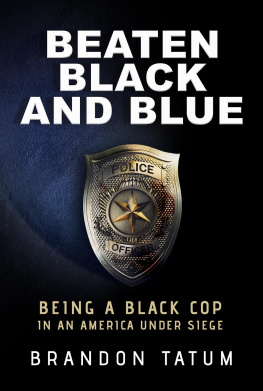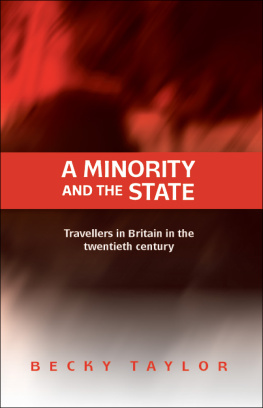First published 2000 by Ashgate Publishing
Reissued 2018 by Routledge
2 Park Square, Milton Park, Abingdon, Oxon OX14 4RN
711 Third Avenue, New York, NY 10017, USA
Routledge is an imprint of the Taylor & Francis Group, an informa business
Copyright Becky L. Tatum 2000
All rights reserved. No part of this book may be reprinted or reproduced or utilised in any form or by any electronic, mechanical, or other means, now known or hereafter invented, including photocopying and recording, or in any information storage or retrieval system, without permission in writing from the publishers.
Notice:
Product or corporate names may be trademarks or registered trademarks, and are used only for identification and explanation without intent to infringe.
Publishers Note
The publisher has gone to great lengths to ensure the quality of this reprint but points out that some imperfections in the original copies may be apparent.
Disclaimer
The publisher has made every effort to trace copyright holders and welcomes correspondence from those they have been unable to contact.
A Library of Congress record exists under LC control number: 99072840
ISBN 13: 978-1-138-70324-7 (hbk)
ISBN 13: 978-1-315-20325-6 (ebk)
Race is a dominant theme in American society. Few issues can be discussed without the factor of race underscoring the analysis. Americas obsession with race is rooted in the reality in which the concept is used. Rather than a method of identifying people according to genetic make-up or physical characteristics, race is primarily used to locate and place people according to culturally defined social positions (Rose, 1990). These social positions are unequal and location in the structural hierarchy determines cultural experiences. As a result, it makes a difference (emphasis mine) what one is called and into what social position one is placed (Rose, 1990).
Much attention and research have been devoted to the role of race in criminal offending. Crime statistics have traditionally suggested a disproportionate involvement in criminal activity by people of color in comparison to their representation in the population. Official data point to young African Americans, especially young African American males, as being the major perpetrators of crime. From 19801990, for example, part one index crime arrests for African American youths ranged from 29% to 37% (FBI, 1991), although they represented less than 5% of the total U.S. population during this time period (Bureau of the Census, 1991). The widest racial gap in juvenile arrests, by far, are for violent crimes, which were reported to be 5 times higher for African American youths than for White youths in 1991 (Snyder and Sickmund, 1993).
Generally, criminologists have attributed high rates of crime and violence among racial minorities to inequities in the social structure. Popular explanations such as social disorganization and strain theories suggest that the greater involvement of nonwhite youths in delinquency is best explained by conditions associated with their lower-class status. These conditions weaken the proficiency of familial and communal institutions to regulate adolescent aspirations and desires, and decrease the ability of nonwhite youths to obtain cultural goals. Blocked opportunities lead to frustration that is acted out through criminal, violent, and delinquent behaviors. The failure of mainstream structural perspectives, however, to explicitly address the role of race and racism in structural relations has lead some minority scholars to suggest the colonial model as an alternative explanation of African American crime and delinquency (Austin, 1983, 1987; Staples, 1975, 1987; Tatum, 1994). From the standpoint of race, the colonial model examines the effects of racial inequality (or oppression) on the personality and behaviors (which are sometimes criminal) of minority individuals. In short, both the mainstream and alternative perspectives argue that crime and delinquency are adaptive responses to structural inequities; the key difference between the two perspectives lies in the use of class versus race as the starting point of analysis.
In Crime, Violence and Minority Youths, we critically examine the ability of both classic structural theories and the colonial model to explain high rates of crime among African and Mexican American youths. We, in turn, propose the neocolonial model as a framework that addresses the limitations of both theoretical perspectives. Findings from a pilot study testing several of the propositions and assumptions of the neocolonial model provide initial insights into the adequacy and theoretical value of the framework.
The contents of the book are presented in seven chapters.. Addressing these limitations, we revise the perspective to form a neocolonial model of adolescent crime and violence.
Although the colonial model is used as a cross-cultural explanation of minority structural experiences, as a theoretical explanation of crime, the perspective has only been applied to African Americans. further reviews the Mexican American class structure, in particular, the applicability of the underclass perspective. Finally, the chapter explores how the social structure impacts the structural status of Mexican American youths and the theoretical implications for crime and violence.
In to the interrelationships among theoretical variables. A general causal model of delinquency is drawn from the perspective and is tested for the combined sample and by race and types of delinquency.
Finally, in , we provide an overview of the results of the pilot study and offer concluding comments regarding the theoretical promise of the colonial perspective.
Note
Victimization and self-report data suggest similar patterns of juvenile offending (see U.S. Department of Justice, 1992; Huizinga and Elliott, 1987). The National Youth Survey (NYS), however, stresses the importance of distinguishing between prevalence and incidence of delinquency. Prevalence comparisons of delinquent behavior show few differences between African American and White juveniles and youths from lower-, working-, and middle-class backgrounds (Elliott and Ageton, 1980). The incidence of delinquent behavior, however, appears to be greater among low-income and African American juveniles (Elliott and Ageton, 1980).







